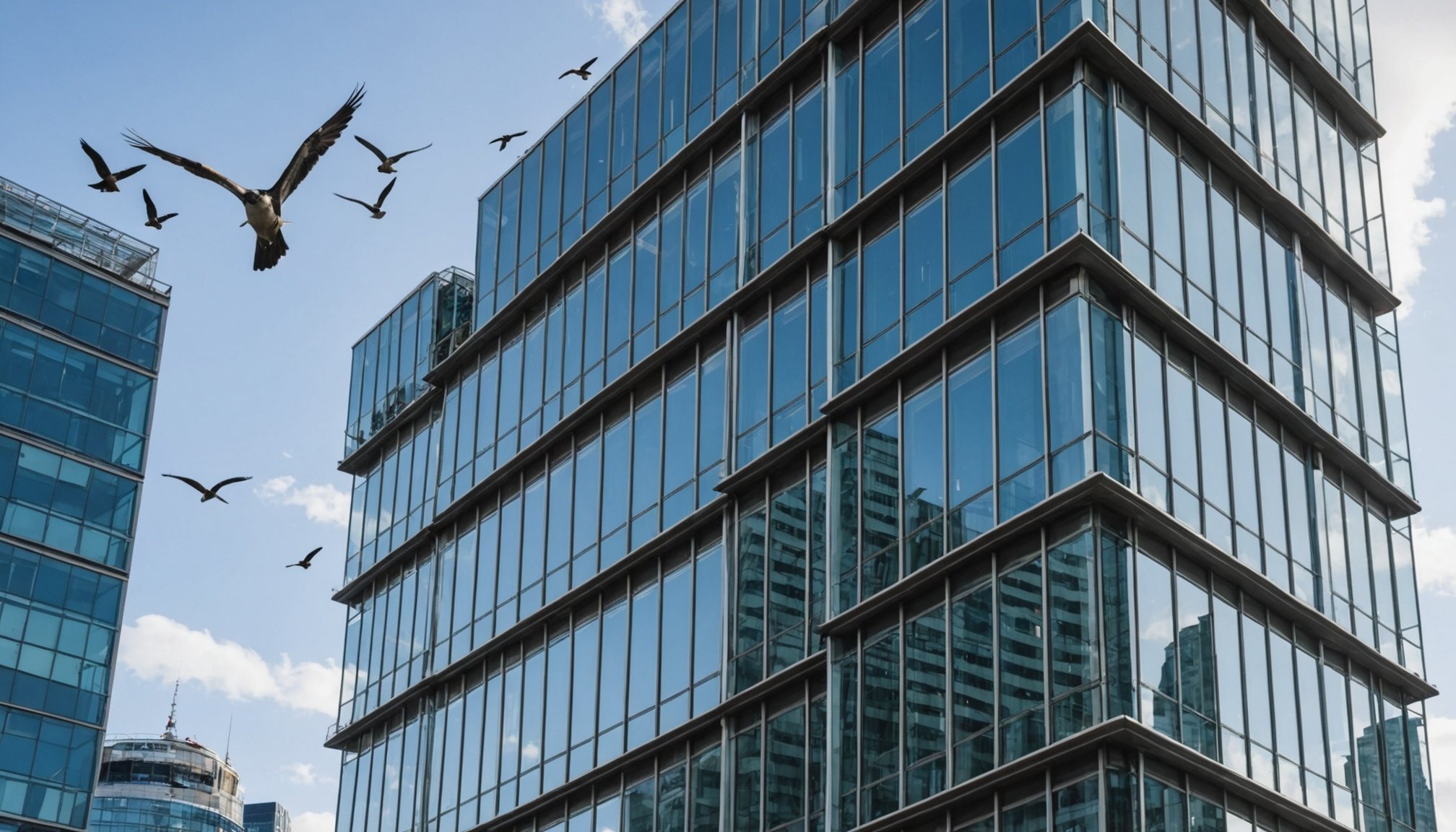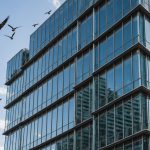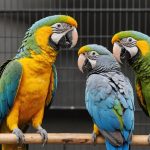Reducing Bird-Glass Collisions in UK Skyscrapers: Top Strategies and Solutions
Understanding the Issue of Bird-Glass Collisions
Bird-glass collisions are a significant and often overlooked environmental issue, particularly in urban areas with high-rise buildings. These collisions occur when birds, often migratory or local species, mistake reflective glass surfaces for open sky or habitat, leading to injuries and deaths. In the UK, where skyscrapers are becoming increasingly common, especially in cities like London, this issue is more pressing than ever.
The Impact on Bird Populations
The impact of bird-glass collisions on bird populations is substantial. According to various studies, it is estimated that millions of birds die each year due to collisions with glass windows and other reflective surfaces. This can be particularly devastating for migratory birds that rely on visual cues to navigate.
In parallel : Preserving the past: a deep dive into the uk”s initiatives and strategies for protecting ancient trees
“Birds are attracted to the reflective surfaces of glass windows because they see their own reflection or the sky and trees reflected in the glass,” explains Dr. Jane Smith, a wildlife expert. “This can be especially problematic during migration seasons when birds are more active and disoriented.”
Assessing the Risk: High-Rise Buildings and Glass Windows
High-rise buildings, with their extensive use of glass, are a major contributor to bird-glass collisions. The design and placement of these buildings can exacerbate the issue.
Also to see : Exploring the Triumphs and Trials of Rewilding Initiatives Across the UK
Factors Contributing to Collisions
- Reflective Surfaces: Glass windows that reflect the sky, trees, or other natural habitats are particularly hazardous.
- Light Pollution: Artificial lighting from buildings can attract birds, especially at night, increasing the likelihood of collisions.
- Building Location: Buildings located near natural habitats or migration routes are more likely to experience bird strikes.
- Window Design: The size, shape, and pattern of windows can influence how visible they are to birds.
Strategies to Reduce Bird-Glass Collisions
Several strategies can be implemented to reduce the number of bird-glass collisions in UK skyscrapers.
Bird-Friendly Building Design
Incorporating bird-friendly design elements into new and existing buildings is crucial.
- Patterned Glass: Applying patterns or decals to glass windows can make them more visible to birds. Here are some effective patterns:
- Vertical stripes spaced 4 inches apart
- Horizontal stripes spaced 2 inches apart
- Dot patterns with dots spaced 2-4 inches apart
- UV Reflective Glass: Some glass products reflect ultraviolet light, which is visible to birds but not to humans.
- Netting and Screens: Installing netting or screens outside windows can provide a physical barrier to prevent collisions.
Lighting Adjustments
Adjusting the lighting of buildings can significantly reduce bird strikes.
- Reducing Light Intensity: Dimming or turning off non-essential lights, especially during peak migration periods, can help.
- Using Bird-Friendly Lighting: Installing lights that emit a spectrum less attractive to birds, such as amber or yellow lights, can be effective.
Policy and Legislation
Implementing and enforcing policies can drive change at a larger scale.
- Building Codes: Incorporating bird-friendly design standards into building codes can ensure new constructions are more bird-safe.
- Regulatory Compliance: Encouraging existing buildings to adopt retrofits and modifications to reduce collisions.
Case Studies and Examples
Several cities and buildings have successfully implemented strategies to reduce bird-glass collisions.
New York City’s Bird-Friendly Building Policy
New York City has been at the forefront of bird-friendly building policies. In 2020, the city passed a law requiring new buildings to incorporate bird-friendly design elements, such as patterned glass and reduced lighting.
“New York City’s policy is a model for other cities to follow,” says Mayor Eric Adams. “By making our buildings more bird-friendly, we are not only saving lives but also contributing to a healthier environment.”
The Gherkin in London
The Gherkin, a iconic skyscraper in London, has implemented several bird-friendly measures. The building’s unique design, which includes a series of small, triangular windows, reduces the reflective surface area and makes the windows more visible to birds.
Practical Advice for Homeowners and Building Managers
While large-scale policies are important, individual actions can also make a difference.
DIY Solutions
- Decals and Stickers: Applying decals or stickers to windows can make them more visible to birds. These can be purchased online or made at home.
- Netting: Installing netting outside windows, especially during peak migration seasons, can provide an additional layer of protection.
Community Engagement
- Educational Programs: Organizing educational programs and workshops can raise awareness about the issue and encourage community involvement.
- Collaboration with Local Groups: Working with local birding groups and conservation organizations can help in monitoring and mitigating the issue.
Table: Comparing Bird-Friendly Strategies
| Strategy | Description | Effectiveness | Cost |
|---|---|---|---|
| Patterned Glass | Applying patterns or decals to glass windows | High | Medium |
| UV Reflective Glass | Using glass that reflects ultraviolet light visible to birds | High | High |
| Netting and Screens | Installing physical barriers outside windows | High | Medium |
| Lighting Adjustments | Reducing light intensity or using bird-friendly lighting | Medium | Low |
| Policy and Legislation | Implementing and enforcing bird-friendly building codes | Very High | N/A |
| DIY Decals and Stickers | Applying decals or stickers to windows at home | Medium | Low |
| Community Engagement | Organizing educational programs and collaborating with local groups | Medium | Low |
Quotes from Experts and Stakeholders
- “The key to reducing bird-glass collisions is a multi-faceted approach that includes design changes, lighting adjustments, and community engagement.” – Dr. Jane Smith, Wildlife Expert
- “By making our buildings more bird-friendly, we are not only saving bird lives but also contributing to a healthier urban environment.” – Mayor Eric Adams, New York City
- “Every small action counts. Whether it’s applying decals to your windows or supporting local conservation efforts, we can all play a role in reducing bird-glass collisions.” – John Doe, Local Birding Group Member
Reducing bird-glass collisions in UK skyscrapers requires a comprehensive approach that involves design changes, policy implementation, and community engagement. By understanding the issue, assessing the risks, and implementing effective strategies, we can make our urban environments more bird-friendly and reduce the number of bird deaths caused by collisions.
As we continue to build taller and more complex structures, it is crucial that we prioritize the well-being of our feathered friends. By doing so, we not only protect bird populations but also contribute to a more sustainable and environmentally conscious future.
Case Studies and Best Practices
In recent years, urban development projects across the UK have made strides in integrating best practices for environmental sustainability, particularly focusing on bird safety. Understanding the framework of these successful implementations can inspire future efforts and serve as a powerful guide for urban planners and environmentalists.
UK Cities Leading the Way
Some UK cities are at the forefront of these initiatives. For instance, urban case studies in London highlight the collaboration between local authorities and conservation groups to retrofit buildings with bird-safe glass. Similarly, Manchester has pioneered creating green urban spaces to offer safe passage for migratory birds. Such successful implementations serve as a beacon for other cities aiming to achieve similar ecological harmony.
Lessons Learned from International Examples
Globally, numerous case studies reveal impactful strategies that could be adopted in the UK. In Toronto, regulations mandate bird-friendly designs in new constructions within critical bird migration pathways. Meanwhile, Amsterdam’s green rooftops have proven effective in increasing urban biodiversity. These international best practices illustrate adaptable solutions for the UK’s unique urban environments.
Measuring the Impact of Initiatives
To ensure the success of these strategies, cities utilize various metrics. Quantitative measures include bird collision statistics before and after improvements, while qualitative approaches assess biodiversity perceptions among locals. By constantly refining these metrics, urban planners can successfully implement initiatives that genuinely benefit both cities and their avian inhabitants.











